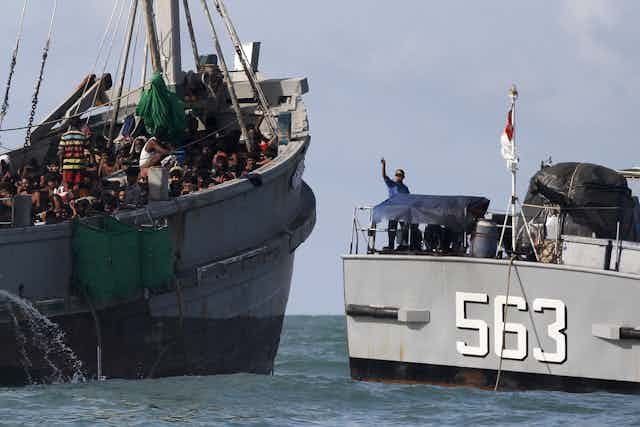Twelve months ago, events in the Andaman Sea exposed the grave reality of forced displacement in Southeast Asia. This culminated in a crisis meeting between governments in Thailand on May 29, 2015.
More than 25,000 people had fled Myanmar and Bangladesh by boat. Around 8,000 were stranded at sea. Around 370 are believed to have died.
The regional response was sorely inadequate. But, one year on, the region is showing signs it is determined to ensure similar crises are avoided.
One million outsiders
The Rohingya people have fled Myanmar and neighbouring Bangladesh by land and sea for decades. They are the largest-known group of stateless people in the world.
An estimated one million Rohingya live in Rakhine State in Myanmar’s west. They are denied basic rights and subject to persecution.
Bangladesh is home to between 300,000 and 500,000 Rohingya. But the United Nations High Commissioner for Refugees considers only around 30,000 to be refugees.
Many of those fleeing have had no choice but to pay for their passage. In many cases this has led to exploitation at the hands of smugglers or traffickers. In recent years the scale and urgency of these movements have increased in response to growing oppression and violence.
What happened a year ago?
On May 1, 2015, a mass grave containing the remains of more than 30 bodies was discovered in the Sadao district of Thailand, a few hundred metres from the Malaysia border.
On May 5, three Thai officials and a Myanmar national were arrested in Thailand for suspected involvement in human trafficking. Two days later more than 50 Thai police officers were reprimanded and a clean-up of suspected camps around the country was ordered.
Interceptions of boats began. Thai, Malaysian and Indonesian authorities reportedly intercepted boats of asylum seekers and pushed them back out to sea. This led to smugglers and traffickers abandoning boatloads of people on the water.
An estimated 6,000 Rohingya and Bengalis were stranded by May 12, most without food or water. Amid ongoing boat pushbacks, around 3,000 people were rescued by Indonesian and Malaysian local officials and fishermen, or swam to shore.
On May 19, the Philippines offered assistance to the Rohingya and Bengali migrants.
The following day, foreign ministers from Thailand, Indonesia and Malaysia met in Malaysia. The Indonesian and Malaysian ministers announced they would no longer push boats back out to sea. They agreed to offer temporary shelter, provided the international community resettled and repatriated the refugees within one year.
Thailand did not sign onto the deal. Indonesia, Malaysia, Thailand, Bangladesh and Myanmar conducted search-and-rescue operations for those still stranded at sea. Thailand deployed navy vessels as floating assistance platforms.
The international community, including Qatar, Saudi Arabia, Japan, Turkey, Gambia and the US, subsequently pledged financial support for relief, processing and resettlement. Some offered settlement places.
Australia pledged A$4.7 million to support populations in Myanmar and Bangladesh. When asked whether any of the refugees would be settled in Australia, then-prime minister Tony Abbott infamously pronounced:
On May 26, Malaysian police found the remains of almost 140 bodies, believed to be migrants from Myanmar and Bangladesh, in abandoned jungle camps near the Thai border. Police officials were detained on suspicion of being involved.
Finally, on May 29, the Thai government convened a special meeting. Fifteen countries and key international organisations participated. They offered an immediate commitment to protect those at sea, announced plans to develop a comprehensive plan to address irregular migration, and agreed to tackle root causes over the long term.
What the region has learned
The collective leadership of the Thai meeting during the Andaman Sea crisis was welcome. But a one-off meeting should not be the norm for managing mass displacement events.
Regional institutions and processes – ASEAN, the Bali Process and the Jakarta Declaration – were largely muted during the crisis. The lack of robust normative or policy frameworks to manage forced migration in the region was exposed. So too was a reticence to create “pull factors”, and the overall absence of protection-sensitive infrastructure.
Tellingly, the Bali Process did not have functioning mechanisms for senior officials across the region to respond. A culture of consensus and non-interference left ASEAN relatively hamstrung.
Bali Process ministers met in March 2016 for the first time since 2013. The outcome reached was significant. There will now be a formal review of the Andaman Sea crisis to draw on lessons learned and work to implement necessary improvements, including contingency planning and preparedness for potential large influxes.
Just as important, a new regional response mechanism has been created. This authorises senior officials to consult and convene meetings with affected and interested countries in response to irregular migration issues or future emergency situations.
Bali Process countries conceded individual and collective responses have been inadequate. The region is now in a position to broker more predictable and effective responses – even preventative action – to forced migration.
These reforms responded to collective disappointment over the failure to act last May. They drew on ideas generated by the Asia Dialogue on Forced Migration.
Importantly, reforms have also occurred in ASEAN, principally through its adoption of a Convention Against Trafficking in Persons, Especially Women and Children, and its renewed commitment to share expertise and development capabilities on regional disaster response mechanisms. This will be vital as climate-induced migration becomes more prevalent.
There has been progress too – albeit limited – on root causes of the crisis. The election of the National League for Democracy as Myanmar’s ruling party has raised hopes the Rohingya people may eventually find a safer home in Rakhine State. And leadership from Indonesia in building schools there and continued pressure from the US continue to be vital.
Regional leaders have started making the right noises, but must continue to take concrete steps.
This is part one of a two-part special on the Andaman Sea crisis a year on. Tomorrow, part two will look at whether the region is better prepared for similar events.

